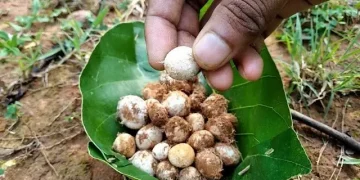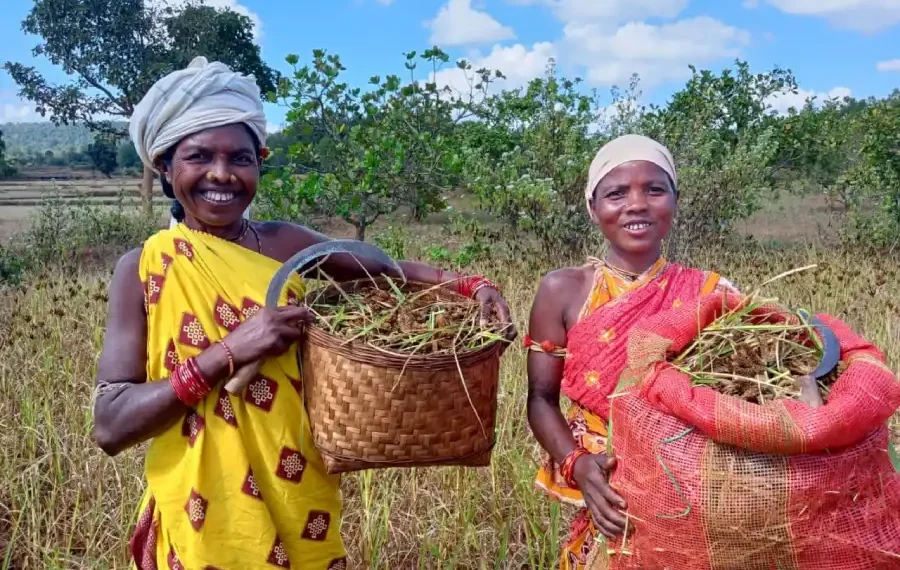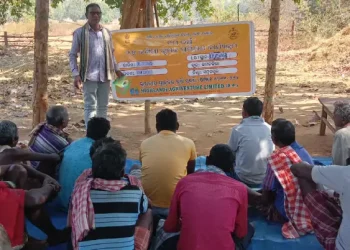Koraput/Bhubaneswar
Paroja tribal, Chitta Chendia, in Machara village of Koraput, Odisha, is over the moon. For, her three acres of lush finger millet (Ragi) of improved variety VL Mandua-380 are expected to yield 10 to 12 quintals of seeds per acre this year in what would be another replay of her earlier achievements.
She hopes that the seeds of this improved variety, provided freely by Jeypore-based outfit MS Swaminathan Research Foundation (MSSRF), would again sell at over Rs. 50 per kilogram.
Earlier, she had been growing indigenous varieties like Chilli and Bhalu that used to yield four to five quintals of seeds per acre. However, their sale in the local market used to earn her only Rs. 17 to Rs. 20 per kilogram.
“I have been growing different improved varieties provided by MSSRF for seeds for the last six years. Every year, improved varieties, sown between June and mid-August and harvested between October and mid-December for seeds, fetch me a good income to manage my family of six members nicely,” said Chitta. “About 45 tribal farmers in Macchra grow improved varieties provided freely MSSRF,” she added.
As the state government pins importance on farming and consumption of mandia (millet) under its Shree Anna Abhiyan (flagged off in 2017 as Odisha Millet Mission), it stresses seed production to have a significant upturn. It has now roped in organizations like MSSRF to distribute seeds among farmers and train them on scientific farming method to achieve this objective.
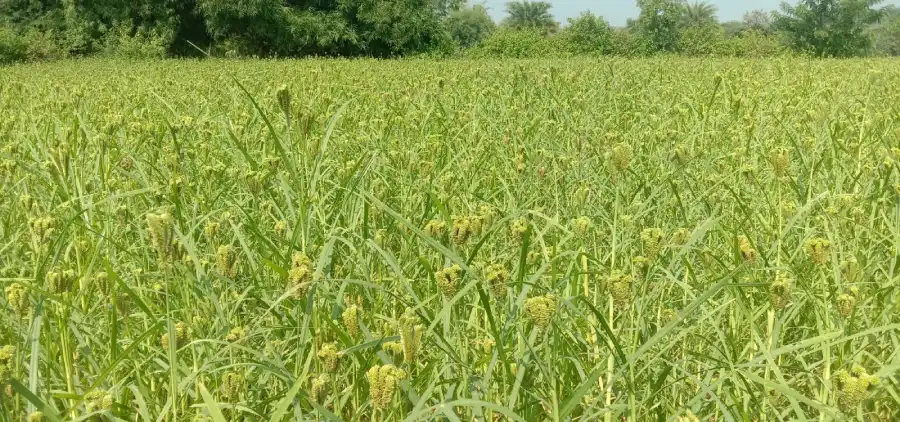
Experts, scientists and government bat for consumption of millets including Ragi, dubbed as ‘super food’ for its nutritional values. The laboratory test of 13 indigenous finger millet genotypes by the Central University of Odisha (CUO) in Sunabeda of Koraput district lends credence to it.
“The laboratory test has proved that finger millets contain sufficient ash (salts of calcium, magnesium, potassium, sodium, potassium, manganese, zinc and iron), carbohydrates, fibre, energy, phenol, flavonoid, Vitamin C and antioxidants. Among the genotypes Telgu, Bada and Dushera have more nutritional compositions,” said Assistant Professor Dr. Debabrata Panda, of CUO’s Department of Biodiversity and Conservation of Natural Resources.
Improved varieties like Kalua, Arjuna, VL Mandua-379, VL Mandua-380, KMR-204 and ML-365 have similar nutritional compositions, but their per acre yield capacity is said to be more than that of their 33 native counterparts grown by tribal farmers who mostly belong to tribal communities like Paroja, Bhumia and Bhumija.
“We have been distributing seeds among farmers since 2018 under Rashtriya Krishi Vikas Yojana (RKVY) Alternative Seed System Model Project of the Union Government, which is implemented by the state government through organizations like ours. We have noticed improved varieties yield seeds 30 percent more than the native ones,” MSSRF’s Director Dr. Prashant Kumar Parida told The Indian Tribal.
Under this project of the Union Goverment’s Department of Science and Technology-Science for Equity Empowerment and Development Division, nearly Rs. 5 crore is involved to engage farmers in growing improved varieties to produce seeds. This budget allocated for the implementation of the project includes the state government’s contribution of about Rs. 2.2 crore.
“Rs. 30 lakh out of Rs 5 crore is expended on organizing about 12 training camps annually to acquaint farmers with scientific farming method. Nursery preparation, Integrated Nutrition Management, Integrated Pest Management, modern transplant and post-harvest technology are some of the components of training programme,” said MSSRF’s scientist Dr. Kartik Charan Lenka.
“MSSRF distributes finger millet seeds among 70 to 90 farmers every year. Each farmer gets 10 kilograms per hectare,” he added.
Asmati Pujari, a Bhumia tribal of Murja village, acknowledged having been benefited from training imparted by MSSRF. Earlier, she used to grow indigenous varieties like Sana and Mama in her two acres. Two years ago, she started farming improved varieties called Arjuna and VL Mandua-380 through the scientific method and the result proved to be satisfying for her.
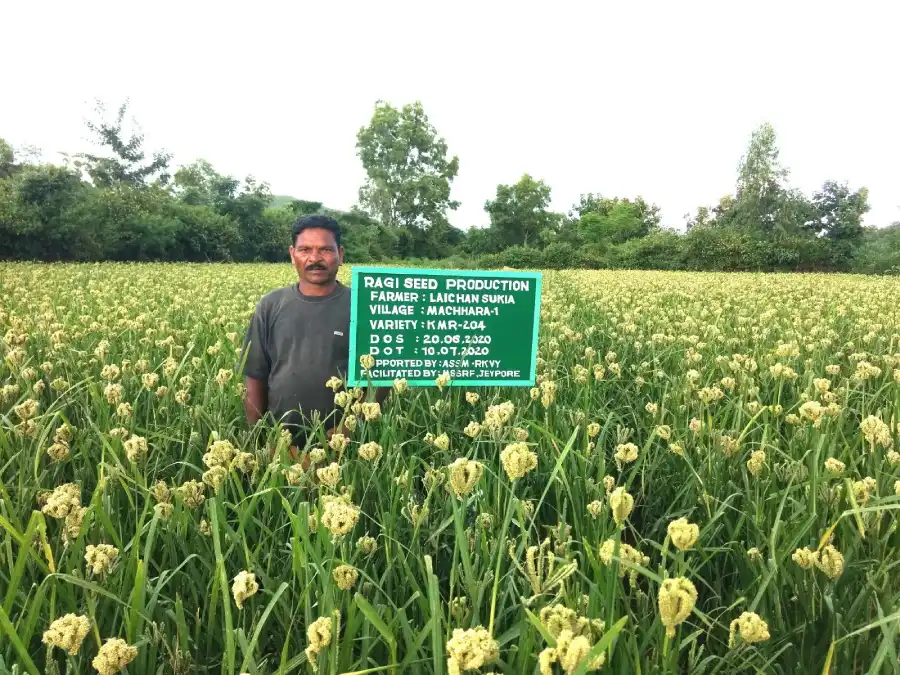
Earlier, she used to sow seeds of native varieties without any systematic method. As a result, they yielded less than five quintals of seeds per acre. However, after she sowed improved varieties, the per acre yield is around 12 quintals.
“I invested around Rs. 3000 per acre to grow native varieties, the yield was dissatisfying and quality of seeds was poor. Though I invested about Rs. 8000 per acre to grow improved varieties, the yield of seeds was really fabulous.” said Asmati.
“I sold seven quintals of finger millet seeds to Odisha State Seeds Corporation Ltd. (OSSCL) at Rs.4200 per quintal and sold off nine quintals in the open market at Rs. 3840 per quintal,” she added.
MSSRF has distributed improved varieties among nearly 163 farmers of 11 villages of Koraput district, who grow them in 50 hectares and sell their seeds from harvested plants to OSSCL and private parties. However, OSSCL does not buy seeds from farmers alone. It also procures seeds from Bhubaneswar-based Odisha University of Agriculture and Technology (OUAT) and other agencies. Later, it sells processed and certified seeds to farmers, farms and agencies that grow finger millet.
“OSSCL procures seeds Arjuna and Kalua developed by us. It also gets seeds from other states and local farmers,” said OUAT’s senior scientist Dr. Pabitra Mohan Mohapatra.
However, breeder seeds are to go through three phases of rigorous certification process, before OSSCL purchases them. The first phase is the flowering stage of finger millet, while the second is the harvesting stage. The third one comes when processed and graded seeds are packaged and tagged,
“We have our field visit during flowering stage to test whether the plants are ‘true to their types’. During our field visit in the second phase, we examine the healthy state of the plants. We are present at the spot during the third when seeds are processed to clean them of dirt and other unwanted ingredients before they are packaged and tagged,” said Pradeep Khora, the certification officer, Koraput.
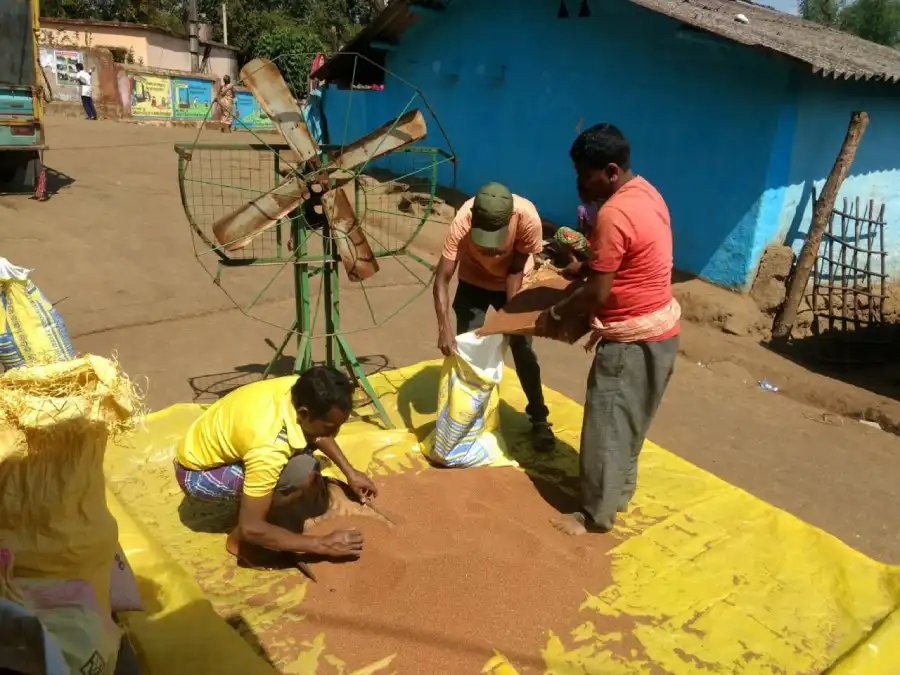
‘Foundation Seeds’, produced from breeder seeds, are the ones collected from the field. After they are processed, they are to be certified for OSSCL to sell them. Last fiscal (2023-24), OSSCL’s ‘all-in-cost price’ of seeds per quintal was Rs. 6886.
Kolab Farmer Producer Company Limited (KFPCL) in village Bagraguda, about six kilometers from Koraput district headquarters, procures seeds from farmers and sells them to OSSCL on behalf of the growers.
“As many as 270 farmers have registered themselves with us as members. Out of them, 165 grow finger millet for seeds that we sell to OSSCL. Each farmer-member gives us Rs. 2 per kilo out of their sale proceeds as our service charge that is spent on the administration and management of our outfit,” KFPCL’s chief executive officer Neeranjan Gauda, who is also MSSRF’s development coordinator, told The Indian Tribal.
However, now improved varieties are not the sole focus. The government is zeroing on good quality local varieties. If these local varieties are grown scientifically that MSSRF lays stress on, their seeds yield can be at par with that of improved varieties, according to Gouda. “The Government is expected to promote farming of indigenous varieties like Mami and Kalia soon, as notification on them has already been issued,” said Gauda.

